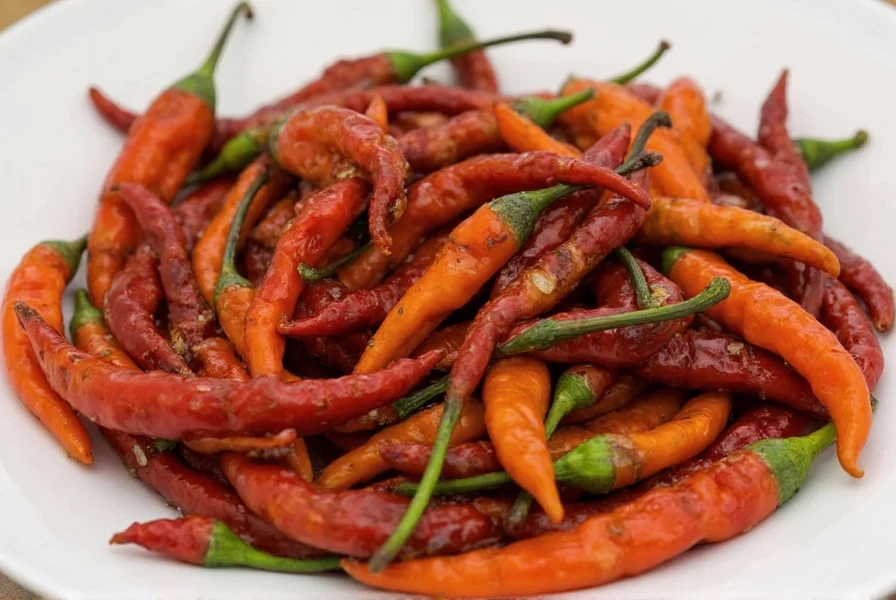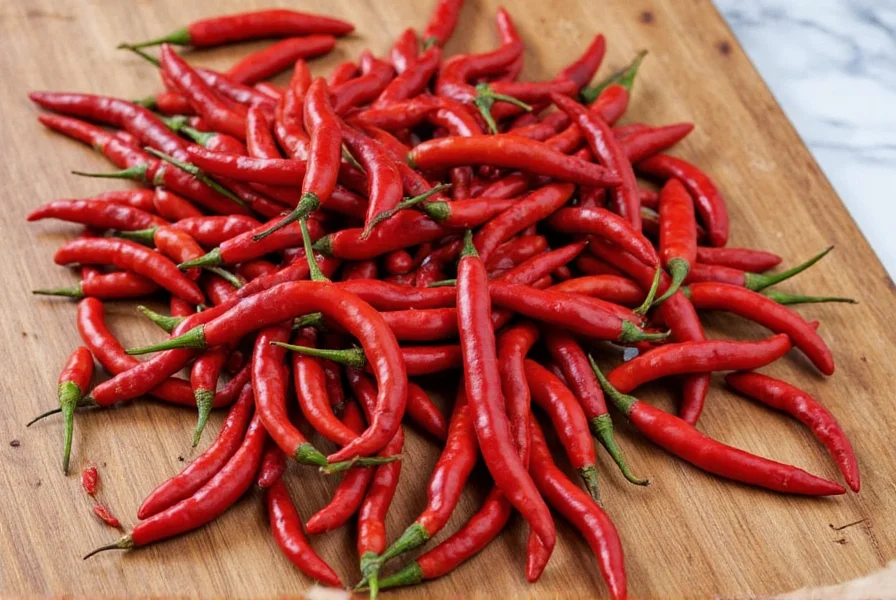Puya chili peppers are a medium-heat dried chili pepper commonly used in Mexican cuisine. With a Scoville rating of 5,000-8,000 SHU, they offer a balanced heat level perfect for everyday cooking. Known for their smoky, earthy flavor and slight fruity notes, puya chilies are versatile ingredients for sauces, moles, soups, and stews.
What Are Puya Chili Peppers?
Puya chili peppers are a staple in traditional Mexican kitchens. Known for their bright red color and slightly wrinkled skin, these dried chilies pack a punch without completely overpowering your palate. They're commonly used in sauces, moles, soups, and stews, bringing both heat and depth of flavor.
Compared to other dried chilies, puya is often overshadowed by its more famous cousins like ancho, guajillo, or chipotle. But don't let that fool you — puya has a charm all its own. It's relatively small (usually around 3–5 inches long), with a thin skin that crisps up beautifully when toasted. Its flavor is bold but not overly complex, making it a versatile option for many dishes.
How Hot Are Puya Chilies?
| Chili Type | Heat Level (SHU) |
|---|---|
| Jalapeño | 2,500 – 8,000 |
| Puya | 5,000 – 8,000 |
| Serrano | 10,000 – 23,000 |
| Hatch Green Chile | 1,000 – 15,000 |
This puts puya at about the same level as a jalapeño, though slightly spicier on average. However, unlike jalapeños, which can vary dramatically in heat depending on growing conditions, puya tends to be pretty consistent. That makes them great for recipes where you want a reliable amount of spice.
Flavor Profile: Smoky, Earthy, and Just Right
While heat levels are important, the real magic of puya lies in its flavor profile. Think of it as the backbone of many classic Mexican sauces — smoky, earthy, and slightly fruity, with a hint of nuttiness. When toasted and rehydrated properly, puya develops a rich, layered flavor that enhances everything from enchiladas to tacos al pastor.
| Chili | Flavor Notes | Best For |
|---|---|---|
| Puya | Smoky, earthy, mildly spicy, slight berry undertone | Salsas, moles, marinades |
| Ancho | Dark fruit, coffee, raisin-like sweetness | Mole sauces, stews, slow-cooked meats |
| Guajillo | Bright acidity, tea-like notes, mild heat | Tamale fillings, enchilada sauce, adobo marinades |
| Morro | Grassy, floral, slightly bitter | Fish tacos, salsas, pickling brines |
As you can see, puya strikes a perfect balance between brightness and richness — not too sweet, not too grassy, just right for everyday cooking.
How to Use Puya Chilies in Cooking
Now that you know how flavorful and moderately spicy puya is, let's get into how to use it effectively in your kitchen. Here are some pro tips to unlock the full potential of this underrated chili:
- Toast Before Rehydrating: To bring out maximum flavor, toast puya chilies in a dry skillet over medium heat for about 2–3 minutes per side until fragrant and slightly blistered. This step intensifies their smoky depth.
- Remove Seeds for Milder Flavor: If you prefer less heat, remove the seeds before using. Most of the capsaicin (the compound responsible for heat) is found in the ribs and seeds.
- Rehydrate with Liquid: Soak the toasted chilies in hot water, broth, or even vinegar for 20–30 minutes until soft. Save the soaking liquid — it adds extra flavor to sauces and soups.
- Blend Into Sauces: Once softened, blend puya with garlic, onions, tomatoes, or tomatillos to make a vibrant red sauce that pairs well with almost any dish.
- Add to Stews and Soups: Toss whole or chopped soaked puya directly into braises or soups for a subtle background heat and flavor.
- Use in Marinades: Combine with citrus juice, herbs, and spices for a powerful marinade that tenderizes and flavors meat beautifully.
Pro Tip: Try adding a few slices of rehydrated puya to your next pot of black beans or lentils for a deeper, more satisfying umami boost.
Buying Guide: Choosing the Best Puya Chilies
When shopping for puya chilies, whether at a local market or online spice shop, here's what to look for to ensure quality and flavor:
- Appearance: Look for deep red color, slightly wrinkled texture, and intact stems. Avoid peppers that are faded, brittle, or have mold spots.
- Smell: Good quality puya should have a strong, earthy aroma. If it smells musty or off, skip it.
- Packaging: If buying pre-packaged, check the expiration date and ensure the packaging is sealed tightly to preserve freshness.
- Source: Mexican-grown puya from Oaxaca or Puebla tends to be more aromatic and flavorful than generic supermarket brands.
Some top products to consider:
| Product | Features | Best For | Price Range |
|---|---|---|---|
| Don Julio Puya Chilies | Authentic Mexican origin, vacuum-sealed packaging, rich aroma | Traditional mole and red sauces | $8–$12 per 10 oz bag |
| La Costeña Dried Puya Chilies | Consistent size and color, easy to find in U.S. markets | Daily cooking and taco nights | $6–$9 per 8 oz bag |
| O Organics Organic Puya Chilies | Certified organic, no preservatives, eco-friendly packaging | Health-conscious cooks and vegetarians | $10–$14 per 7 oz bag |

Storage Tips: Keep Them Fresh Longer
To keep your puya chilies tasting their best, proper storage is key. Here's how to store them:
- Airtight Container: Store in a cool, dark place in an airtight container or ziplock bag. This helps prevent moisture and keeps the chilies from getting stale.
- Freeze for Long-Term: For extended shelf life (up to a year), freeze the chilies in a sealed bag. No need to thaw before use — just toss them straight into soups or sauces.
- Avoid Sunlight: Exposure to light can degrade flavor and color, so keep them away from direct sunlight.

Alternatives: What If I Can't Find Puya?
Running low on puya? No worries! There are several substitutes that come close in flavor and heat:
- Guajillo: Slightly milder and sweeter, with similar smokiness. Great in sauces and marinades.
- Mirásol: Similar heat level, but brighter and slightly more floral. Ideal for salsas.
- New Mexico Chile: Milder and slightly sweeter, works well in Tex-Mex dishes.
Keep in mind that each alternative brings its own unique character to a dish, so adjust your expectations accordingly.
Frequently Asked Questions About Puya Chili Peppers
What are the top 5 pro tips for getting authentic smoky flavor from puya chilies?
1) Always toast puya chilies in a dry skillet before rehydrating to unlock their smoky depth. 2) Use warm broth instead of water for rehydration to add extra flavor dimension. 3) Remove seeds for milder heat while preserving smoky flavor. 4) Blend with roasted garlic for enhanced complexity. 5) Simmer rehydrated chilies in your sauce for at least 20 minutes to fully incorporate their flavor.
How long should I toast puya chilies for optimal flavor?
Toast puya chilies for 2-3 minutes per side over medium heat until they become fragrant and slightly blistered. Be careful not to burn them, as this will create a bitter taste. The chilies should feel pliable but not brittle after toasting.
Can I use puya chilies in place of chipotle peppers?
While both have smoky profiles, they're not direct substitutes. Puya chilies offer a lighter, fruitier smoke compared to the intense, tobacco-like smoke of chipotles. If substituting, use about 50% more puya to achieve similar smokiness, and consider adding a pinch of smoked paprika to bridge the flavor gap.
How can I tell if my dried puya chilies have gone bad?
Fresh puya chilies should have a deep red color and strong earthy aroma. If they've turned brownish, feel excessively brittle, or have lost their fragrance, they've likely passed their prime. Visible mold or musty smells are clear indicators they should be discarded.
What's the best way to store rehydrated puya chilies?
Store rehydrated puya chilies in an airtight container with some of their soaking liquid in the refrigerator for up to 1 week. For longer storage, blend them into a paste with a little oil and freeze in ice cube trays, then transfer the frozen cubes to a sealed bag for up to 6 months.
Are puya chilies and guajillo chilies the same thing?
No, they're different varieties. Puya chilies are smaller, thinner, and slightly hotter (5,000-8,000 SHU) with more pronounced smokiness. Guajillo chilies are larger, milder (2,500-5,000 SHU), and have brighter, more acidic notes. They can sometimes substitute for each other but will create different flavor profiles.
Conclusion: Spice Up Your Life with Puya!
Puya chili peppers may not always steal the spotlight, but once you discover their smoky, earthy charm, you'll wonder how you ever cooked without them. With a balanced heat level and a flavor that enhances rather than overwhelms, puya is the perfect ally for anyone looking to elevate their home cooking with authentic Mexican flair.
So next time you're raiding the spice aisle or planning your weekend cooking project, grab a handful of puya chilies. Toast, soak, blend, and enjoy the transformation they bring to your plate. Trust us — your taste buds will thank you!










 浙公网安备
33010002000092号
浙公网安备
33010002000092号 浙B2-20120091-4
浙B2-20120091-4